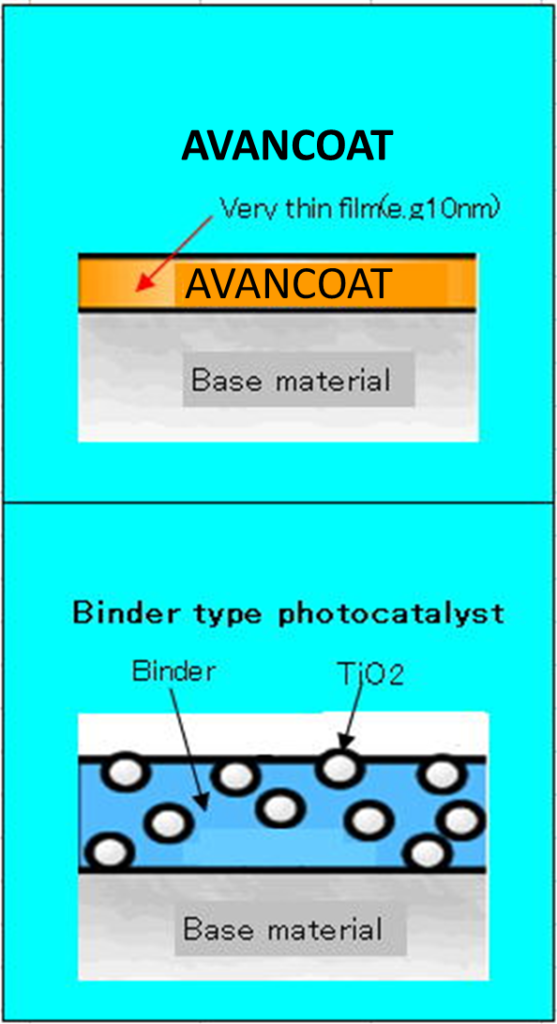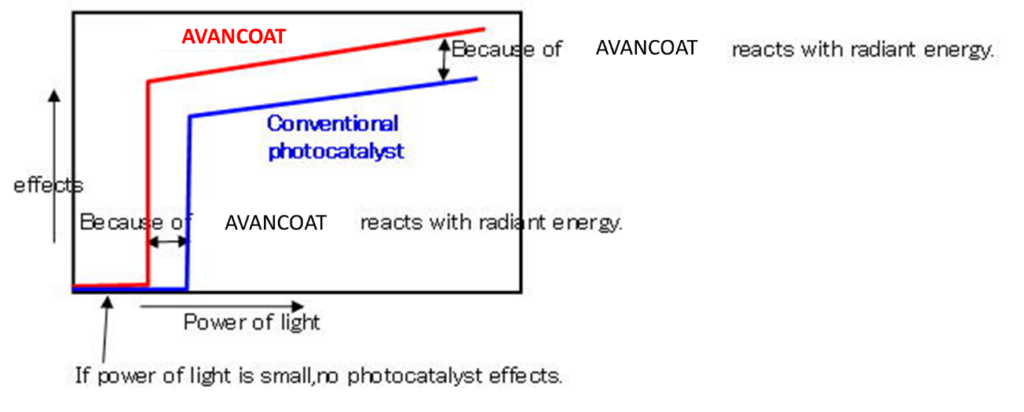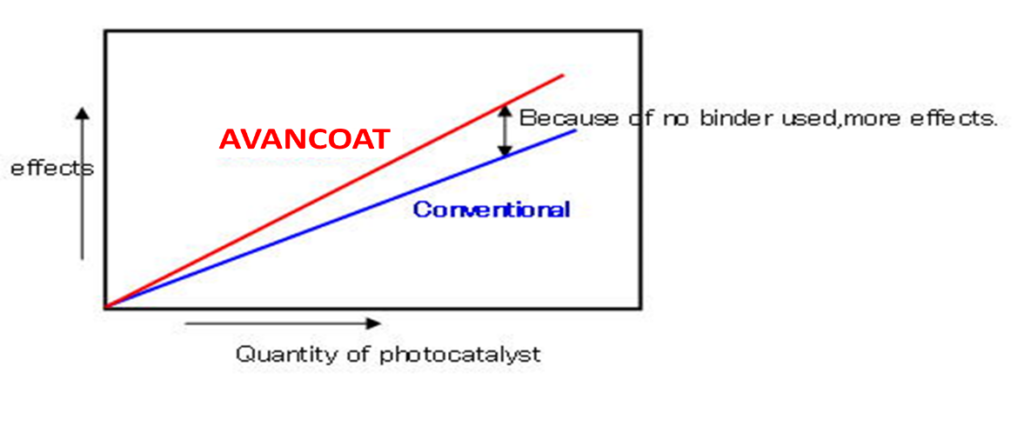AVANCOAT
01. What is AVANCOAT ?
02. Basic effects of AVANCOAT
03. Features of AVANCOAT
04. Safety aspects of AVANCOAT
05. Series of AVANCOAT
06. Coating method
07. The strength of light & effects
08. Actual results of AVANCOAT
09. Instructions for use of AVANCOAT
1.What is AVANCOAT ?
AVANCOAT is a epoch-making photocatalyst developed by AVANTI CO.Ltd (Japanese chemical maker) together with a famous professor of a Japanese university. AVANCOAT is a liquid type of photocatalyst based on Titanium hydroxide.(Normal photocatalyst is based on Titanium dioxide)
2.Basic effects of AVANCOAT
(1)Deodorization & decomposition
Decompose formaldehyde and VOC(volatile organic chemical substance),which are the cause of “sick house syndrome”.
Deodorize the indoor air by composing acetaldehyde, ammonia etc.
<application>Houses, Buildings, Hotels, Hospitals, cars, trains, buses
(2)Anti-bacteria
Anti-bacteria effects to harmful bacteria etc.
<application>Houses, Buildings, Hotels, Hospitals, cars, trains, buses
(3)Self-cleaning, anti-fogging
Hydrophilicity prevent from fogging of glasses and mirrors. In addition, soils on the surface can be easily removed with water(Self-cleaning).
<Application>Buildings, glasses, windscreen of a car, rearview mirror, tents, trains etc.
3.Features of AVANCOAT
Followings are the features of AVANCOAT compared to conventional photocatalysts.

(1)No binder needed when coating
Binder is a bonding material which makes photocatalyst fix on the objects. Conventional photocatalyst is a power type based on TiO2, it need binder to coat on. Therefore, it need time and cost.
AVANCOAT is a liquid type based on Titanium Hydroxide Ti(OH)x (x=2,3 and 4). AVANCOAT is a mixture of non-crystal and crystal type of Titanium hydroxide and the minimum theoretical size is 1.27nm. After coated on the objects, it becomes crystals of Ti(OH)x, TiO2(anatase) and TiO2(rutile) .This reaction will be completed at 20degrees. In the conventional method, it need 500degree to make crystal.
As AVANCOAT can be crystallized in room temperature, binder is not needed.
In addition, as shown in the following chart, only some part of TiO2 is exposed on the surface in case of conventional photocatalyst. Regarding AVANCOAT is can be coated in very thin (such as 10nm), many of crystals are exposed on the surface. That is why AVANCOAT is more photocatalyst effects. It is said powder size of conventional photocatalyst is 1micron to 10micron.
(2)AVANCOAT reacts not only by UV, but also by radiant energy.
Conventional photocatalyst reacts only by UV, but AVANCOAT reacts by radiant energy as well. This is because AVANCOAT is slightly red color by keeping titanium hydroxide in excess condition of oxygen with our unique method. Red color absorbs blue color and it make photocatalyst reaction using a part of energy which it absorbed.

4.Safty aspects of AVANCOAT
AVANCOAT is a safety chemical.
Main ingredient of AVANCOAT is Titanium hydroxide Ti(OH)x. After dry, it becomes crystals of TiO2(anatase),TiO2(rutile) and Ti(OH)x. Once crystallized, AVANNCOAT fix on the object at the hardness of 9H. 9H means if you rub with a pencil of 9H hardness, the fixed AVANCOAT cannot be peeled. Hardness of conventional photocatalyst is 2H-4H.
Titanium is widely used in our life such as golf clubs, artificial bones, teeth etc. White chocolate is made from titanium dioxide. Titanium dioxide is made from Titanium Hydroxide. Therefore AVANCOAT is safe material and environmentally friendly.
5.Series of AVANCOAT
There are the following kinds of AVANCOAT.
Right product should be selected depending on the application.

6.Coating method
(1)Indoor coating
<Object> Deodorant, Anti-bacteria, house sick syndrome
Product AVANCOAT SN
Spray the following spray SLV-2 is our recommendation. It can spray mist of 2.5micron, and coat in the room uniformly. As the power supply is 100V, please provide transformer and plug.


Preparation
(1) Measure the floor space and fix a AVANCOAT volume and spraying time depending on the table.
ex. spraying a room of 20m2,use 600 mL of AVANCOAT SN and spraying 50.8minutes.
(2) Cover TV, PC, electronics equipment, paintings, adornments, or move out from the room. Move pets out from the room.
(3)Cover smoke detectors and fire detectors.
(4)Clean up the room. In case of kitchen, remove oil. In case of toilet, remove all the cause of smell.


2.Spraying
(1)Fill in AVANNCOAT in SLV-2.
(2)Set SLV-2 in the right place in order to spray evenly in the room.
(3)Wearing mask, goggle, cap, gloves is recommended.
(4)Start spraying.
(5)Get out from the room during spray.
(6)Don’t enter the room for 1hour after finishing spraying.
(7)After 25 hours AVANCOAT fix to the surface. Before that don’t touch the surface.
<Notes>
1.AVANCOAT react with radiant rays, but it is more effective in the room which sun light comes.
2.AVANCOAT continue the effects permanently.
(2)Outdoor coating
*Outdoor coating for self-cleaning needs a lot of know-how. Please ask us for further information.
Before coating on the object, you need to make the surface of the object hydrophilic.


<note>
1.To have self-cleaning effects, you need light and rain.
2.You cannot coat photocatalyst on an organic matter.
(3)Coat in advance
In Japan, many case of advanced spraying are booming. Such as cars, window glasses, tiles etc.
7. The strength of light & effects
Power of light (UV + Radiant energy), quantity of photocatalyst and effects are as follows.
(1) Under the condition of same photocatalyst quantity

(2) Under the condition of same power of light

8.Actual results of AVANCOAT
We have a lot of actual results in Japan such as hotels, apartment houses, hospitals, companies, inside of cars.
We also have a lot of business talks using car (inside, outside),trains, buses, house maker, textiles and building materials.
9.Instructions for use of AVANCOAT
1. If photocatalyst sprayed onto organic matter (ex. painting) outside of the house which sunlight receives, organic matter will be reacted.
2. Thickness of the photocatalyst after applied by SLV-2 is around 10-20nm.
3. If coated on the glass over 50nm, glass will be colored in iridescent.(don’t do this)
4. Provide additional light when you use in dark room such as hospitals.
5. Shake the bottle before using.
6. Add some ethyl alcohol for better spraying.
7. To prevent from freezing, add some ethyl alcohol if needed.
8. Need 180mL photocatalyst per a car in spray in the car.
9. If you need self-cleaning, please note you need light and rain.
プラネットコーポレーション_レターベッド_ヘッター.png?1767588355)